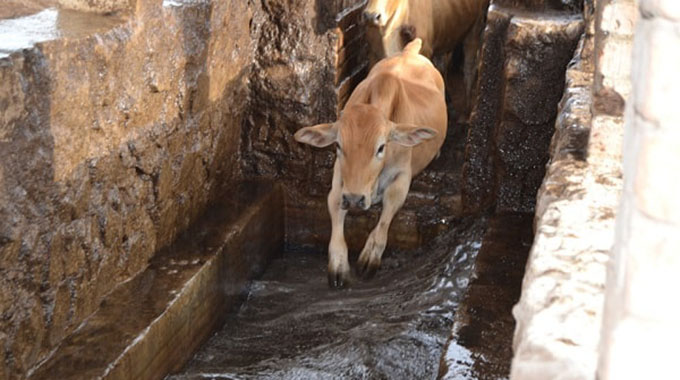
The Sunday News

ONE of the issues that one notices with regards to dipping facilities in smallholder communal areas is that dip tanks are far and wide apart. Secondly, the dipping infrastructure has seen better days, with some dip tanks having been constructed in the 1950s.
Thirdly, these structures tend to have water challenges because most of them were sited next to rivers and streams that used to be the source of water, now those streams and rivers no longer have water, or they quickly dry off due to siltation and climate change issues.
Again, some of the dip tanks have huge livestock censuses of over 3 000 cattle when the acceptable number is at least a maximum of 1500 animals per dip tank for effective dipping. So, you have a dip tank which by right was designed for a livestock census of 1 500 animals, but it is now servicing 3 000 animals, something is being sacrificed in the process, it could be the infrastructure or effective dipping or both.

cattle
All these issues mentioned above point to the need for improvement with regards to communal dipping infrastructure within the community. It is my submission that for farmers and the nation to control and contain tick-borne diseases we need to revamp our dipping infrastructure as well as improving the actual dipping itself.
This can happen if we improve the following important aspects of the dipping infrastructure. The first aspect should be to construct new dip tanks to either augment the existing one or to replace them completely. As alluded to earlier on, most of the dip tanks are very old and some have cracks — which are difficult to mend, hence constructing a new structure altogether would be helpful.
Government and its development partners would do well as part of livestock development to consider constructing new dipping infrastructure. The structure may also need to be modernised such as provision of solarised water reticulation system for easy filling up of the dip tank and holding dipping sessions.
In some areas dipping is irregular not for lack of dipping chemicals but because of the cumbersome water system. In other areas the dip tanks have no boreholes and communities must cart water from their homes to fill up a ten thousand-litre dip tank, and that’s no small task. Consequently, some weeks community members fail to fill up the tank and dipping is sacrificed with devastating effects on disease management.

Modernisation of dipping infrastructure may also mean putting spray races instead of the plunge pool and this can make dipping a whole lot better for livestock farmers. Another issue will be to review optimum livestock censuses per dip tank downwards so that no single dip tank is overloaded. A dip tank with smaller number of livestock and stock owners is easier to manage for the farmers especially in cases where they need to contribute for the purchase of acaricides.
A larger group of stock owners is difficult to handle because of the broad group dynamics issues. At least if the optimal livestock census per dip tank can be reviewed downwards to a maximum of 500 animals only. In addition, it should be mandatory for a dip tank to have a borehole next to it for easy filling up the tank and ensuring regular dipping.
Constructing a dip tank with no water source close by, is nothing less of a perennial punishment to livestock farmers who have to endure the tedious and cumbersome process of carting water from far away sources to the dip tank. Most importantly Government needs to promote self-supply of acaricides (dipping chemicals) by livestock farmers. Stock owners need to also own the health management of their animals.
The self-supply system of acaricide has been piloted by Government in partnership with development agencies and it has come in very handy in times when Government has delayed provision of acaricides. This needs to be upscaled to other regions beyond the pioneering districts so that never again should farmers fold their hands and wait for Government to provide acaricides.
Uyabonga umntakaMaKhumalo. Mhlupheki Dube is a livestock specialist and farmer. He writes in his own capacity. Feedback [email protected]/cell 0772851275



